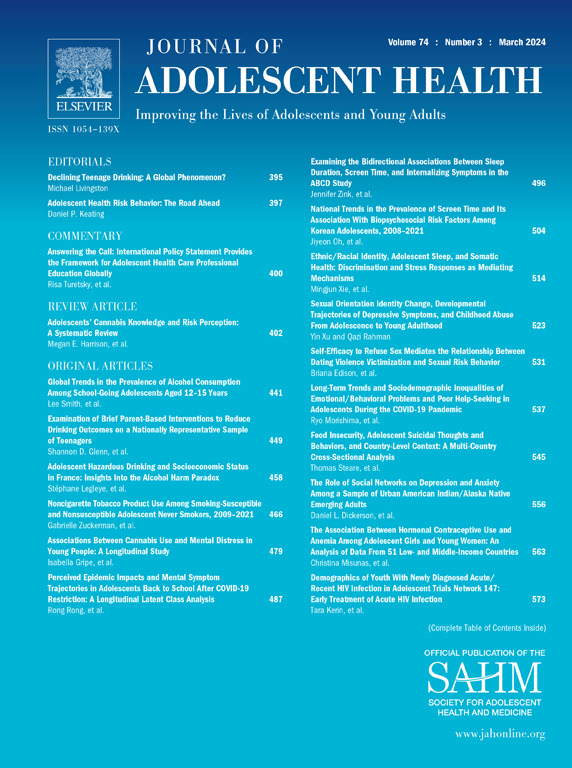Evidence Gaps in Economic Evaluations of HIV Interventions Targeting Young People: A Systematic Review
IF 5.5
2区 医学
Q1 PEDIATRICS
引用次数: 0
Abstract
Purpose
Young people living with HIV (YPLWH) face the burden of navigating the unique physical, psychological, and social challenges of adolescence while coping with a stigmatized infectious disease that requires lifelong care. Consequently, YPLWH experience worse HIV outcomes compared to children and adults. This systematic review seeks to collate evidence on the health and economic impact of HIV interventions targeting YPLWH and to identify gaps in the available evidence that may inform future economic evaluations of interventions for YPLWH.
Methods
We searched the MEDLINE, Embase, Scopus, and Global Index Medicus databases for peer-reviewed articles published through April 24, 2022 (PROSPERO ID: CRD42022356244). Our inclusion criteria encompassed economic evaluations of HIV interventions that report health and economic outcomes among individuals ages 10–24 years. Three investigators screened articles at the title, abstract, and full-text levels. The data were extracted in accordance with the Consolidated Health Economic Evaluation Reporting Standards 2022.
Results
Of the 3,735 unique articles retrieved through our search, 32 met our inclusion criteria. Of these 32 articles, 8 (25%) evaluated a behavioral, educational, or financial intervention, 6 (19%) voluntary medical male circumcision, 5 (16%) HIV screening or testing, 4 (13%) pre-exposure prophylaxis, 3 (9%) a hypothetical HIV vaccine, 2 (6%) antiretroviral therapy, 1 (3%) condom distribution, and 3 (9%) a combination of interventions. Twenty-two studies (69%) focused on Africa, 9 (28%) on North America, and 1 (3%) on Europe. Thirty studies (94%) were cost-effectiveness analyses and 2 (6%) were cost-utility analyses. Of the intervention types captured by this review, most were deemed cost-saving or cost-effective. Only two studies—one evaluating a financial intervention and one evaluating HIV testing—concluded that the intervention was not cost-effective.
Discussion
Evidence presented by this review suggests that investments in HIV prevention and treatment for young people can be a cost-effective, and sometimes cost-saving, solution to combating the global HIV epidemic. However, additional evaluations of HIV interventions targeting young people, which adhere to standardized reporting practices, are needed to permit comparability of cost-effectiveness outcomes between interventions and settings.
针对年轻人的艾滋病干预措施经济评估中的证据差距:系统回顾。
目的:青少年艾滋病病毒感染者(YPLWH)既要应对青春期特有的生理、心理和社会挑战,又要应对需要终生护理的耻辱性传染病,负担沉重。因此,与儿童和成人相比,青少年艾滋病感染者的治疗效果更差。本系统性综述旨在整理有关针对青壮年妇女和儿童的 HIV 干预措施对健康和经济影响的证据,并找出现有证据的不足之处,为将来对青壮年妇女和儿童的干预措施进行经济评估提供参考:我们在 MEDLINE、Embase、Scopus 和 Global Index Medicus 数据库中检索了 2022 年 4 月 24 日之前发表的同行评审文章(PROSPERO ID:CRD42022356244)。我们的纳入标准包括对 10-24 岁人群的健康和经济结果进行报告的 HIV 干预措施经济评估。三名调查人员对文章的标题、摘要和全文进行了筛选。根据《2022 年卫生经济评价合并报告标准》提取数据:在我们检索到的 3735 篇文章中,有 32 篇符合我们的纳入标准。在这 32 篇文章中,有 8 篇(25%)评估了行为、教育或经济干预措施,6 篇(19%)评估了自愿包皮环切手术,5 篇(16%)评估了 HIV 筛查或检测,4 篇(13%)评估了暴露前预防,3 篇(9%)评估了假设的 HIV 疫苗,2 篇(6%)评估了抗逆转录病毒疗法,1 篇(3%)评估了安全套发放,3 篇(9%)评估了综合干预措施。22 项研究(69%)侧重于非洲,9 项(28%)侧重于北美,1 项(3%)侧重于欧洲。30 项研究(94%)进行了成本效益分析,2 项(6%)进行了成本效用分析。在本综述所涉及的干预类型中,大多数被认为是节约成本或具有成本效益的。只有两项研究--一项评估了财务干预措施,一项评估了 HIV 检测--得出的结论是干预措施不具成本效益:讨论:本综述提供的证据表明,投资于年轻人的 HIV 预防和治疗是一种具有成本效益的解决方案,有时甚至可以节省成本,以应对全球 HIV 流行。然而,还需要对针对年轻人的艾滋病干预措施进行更多的评估,这些评估应遵守标准化的报告惯例,以便对不同干预措施和环境下的成本效益结果进行比较。
本文章由计算机程序翻译,如有差异,请以英文原文为准。
求助全文
约1分钟内获得全文
求助全文
来源期刊

Journal of Adolescent Health
医学-公共卫生、环境卫生与职业卫生
CiteScore
10.40
自引率
3.90%
发文量
526
审稿时长
46 days
期刊介绍:
The Journal of Adolescent Health is a scientific publication dedicated to enhancing the health and well-being of adolescents and young adults. Our Journal covers a broad range of research topics, spanning from the basic biological and behavioral sciences to public health and policy. We welcome a variety of contributions, including original research papers, concise reports, literature reviews, clinical case reports, opinion pieces, and letters to the editor. We encourage professionals from diverse disciplines such as Anthropology, Education, Ethics, Global Health, Health Services Research, Law, Medicine, Mental and Behavioral Health, Nursing, Nutrition, Psychology, Public Health and Policy, Social Work, Sociology, and Youth Development to share their expertise and contribute to our mission of promoting adolescent health. Moreover, we value the voices of young individuals, family and community members, and healthcare professionals, and encourage them to submit poetry, personal narratives, images, and other creative works that provide unique insights into the experiences of adolescents and young adults. By combining scientific peer-reviewed research with creative expressions, our Journal aims to create a comprehensive understanding of the challenges and opportunities in adolescent and young adult health.
 求助内容:
求助内容: 应助结果提醒方式:
应助结果提醒方式:


